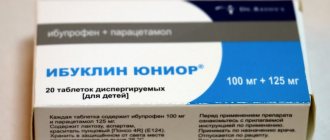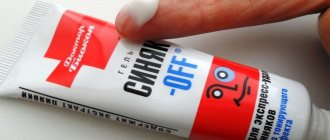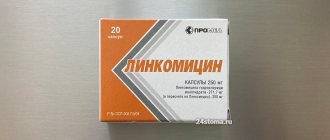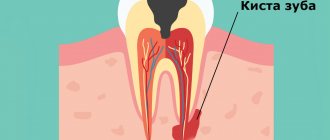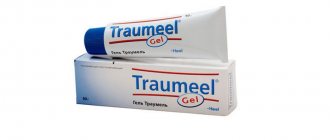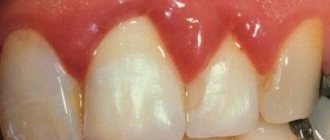From this article you will learn:
- what to do if the gum around the tooth is inflamed,
- what are the causes of inflammation,
- Medicines for gum inflammation are fast-acting and inexpensive.
The article was written by a dentist with more than 19 years of experience.
Depending on the cause of its occurrence, gum inflammation can be observed either in the area of most teeth (which is typical for gingivitis and chronic generalized periodontitis), or there can be a local inflammatory process developing in the area of just 1-2 teeth. The latter is typical for localized periodontitis, as well as for purulent periodontitis of the tooth.
How to treat gum inflammation (including medications) will depend on the cause of the inflammation, as well as the severity of the inflammatory process. If we are talking about gum inflammation due to gingivitis or periodontitis, in this case treatment will consist of anti-inflammatory therapy (antiseptic rinses, gel applications on the gums, sometimes antibiotics), as well as procedures for removing supragingival and subgingival dental plaque.
Inflammation of the gums: photo of catarrhal gingivitis
A completely different treatment is required if the inflammation of the gums near the tooth is local in nature (in the area of only 1-2 teeth). The causes of such inflammation can be - 1) overhanging edge of the filling and crown, injuring the gingival margin, 2) traumatic supercontacts between the upper and lower teeth, 3) inflammation at the apex of the tooth root. Therefore, if the gums near the tooth become inflamed, what to do in such situations is always to eliminate the specific causative factor that caused the inflammation. But drug treatment with drugs will not play a very big role in these cases.
The author of this article worked as a periodontist for more than 10 years, treating gum disease in patients, and therefore our recommendations really work (state-issued documents on advanced training in the Periodontology program can be seen in the editorial section). Below we will talk about inexpensive and effective drugs for the treatment of gum inflammation.
Content:
- Types and purpose
- Anti-inflammatory
- Painkillers
- Wound healing
- Comprehensive periodontal treatment
- Rules of application
The products of the pharmaceutical industry are extremely diverse, including those for dental clinics. Without outside help, it can be difficult to figure out when gum ointment is needed and how an anesthetic dental gel differs from it. The review article will help classify the products prescribed by dentists according to their effects and composition, but this is in no way a guide to their independent use.
Names of antibiotics used for inflammation of the dental nerve and root
The dentist prescribes medications to suppress infection based on the results of an examination of the problem area. When the nerve is inflamed, it is difficult to eat and drink; throbbing or aching pain accompanies a person throughout the day and intensifies at night.
Before starting therapy, the doctor conducts an allergy test and interviews the patient to identify contraindications.
Antibiotics help eliminate inflammation of the root and dental nerve:
- Ciprofloxacin.
- Azithromycin.
- Amoxiclav.
- Azithromycin.
- Ampiox.
- Doxycycline.
- Digital
Types and purpose
Gum inflammation is a widespread problem. There are many reasons for it, but the results are always the same: they turn red and bleed, and there is an unpleasant odor from the mouth. Periodontists practice complex treatment: antibacterial medications for oral administration, physical therapy and local therapy.
For local therapeutic effects, antiseptics and analgesics are used in powders and rinsing solutions, but ointments and gels that act in a targeted, effective and long-lasting manner are more convenient. They are quickly absorbed, therefore they actively influence the affected tissues, shorten the healing time and alleviate the patient’s condition. Their peculiarity is the almost complete absence of contraindications, except for individual intolerance and a minimum of adverse reactions compared to other dosage forms.
All such preparations, spread and rubbed into the oral cavity, are usually classified into groups that differ in the basis that binds the active components:
- gels are water-soluble, they are light and have good absorption, so the active components immediately reach the diseased organ in full, in addition, the film formed on the surface acts as an additional protection for the mucous membrane:
- ointments are oily, have a dense and heavy consistency, which is poorly absorbed and washed off with saliva.
Only a doctor will be able to select the right type of medicine, based on the clinical picture of the disease and taking into account the individual characteristics of the patient.
Causes of gum inflammation
All possible causes of the disease are divided into two large groups - internal and external.
Internal reasons include:
- mental disorders, stress, nervous strain;
- eruption of wisdom teeth;
- diseases of the digestive system;
- lack of microelements and vitamins in the body necessary for healthy teeth and gums;
- diabetes;
- weakened immune system;
- metabolic disorders, hormonal imbalance and a number of others.
External factors that can lead to the development of gingivitis:
- burns and injuries to the oral mucosa;
- bad habits (tobacco smoking, alcohol abuse);
- infections and chronic diseases of the oral cavity;
- poor oral hygiene – leads to the accumulation of pieces of food between the teeth, rotting, and the formation of tartar, which puts pressure on the gums and provokes their inflammation;
- incorrectly installed veneers, braces, fillings that injure the gums and oral mucosa;
- mouth breathing.
Anti-inflammatory
They help relieve pain, relieve swelling and itching, and reduce bleeding. They are prescribed after dental operations on the gums, after tooth extraction, implantation and other complex manipulations. This is a large group for the complex treatment of diseases with inflammatory and infectious processes:
- Gingivitis. Infection of the oral cavity occurs due to insufficient hygiene due to the accumulation of microorganisms. Bleeding of the affected areas and the development of severe complications are possible.
- Stomatitis is painful inflammation localized on the tongue, cheeks, and gums.
- Periodontitis is a disease that threatens the loss of a fragment of the jaw, with the formation of plaque, stones, and suppuration. It is painful.
- Periodontal disease is the gradual destruction of tissues surrounding and holding the elements of the jaw in their sockets, as well as mucous membranes and bone, causing atrophy, a decrease in bone volume with exposure of tooth roots.
Very popular in this line:
- Metrogyl Denta is a combined antibacterial gel for the treatment of infections of various etiologies.
- Dental, in addition to anti-inflammatory properties, has analgesic and wound healing properties.
- Solcoseryl is most in demand in dental practice. Unlike many others with similar effects, it is a medicine, not a balm, therefore it is often used for candidiasis, viral, traumatic and ulcerative necrotic stomatitis. Accelerates tissue regeneration.
- Cholisal - antimicrobial and analgesic effects. Inhibits the inflammatory process, reduces heat at the site of application.
Injections of antibiotics into the gums –
I would like to say a few words about such a treatment method as injections of antibiotics into the gums. This method of treatment has never been used abroad due to the enormous harm that such injections cause to the gums. In Russia, this method of treatment was previously very common due to its low cost and low qualifications of dentists (in conditions where the treatment of periodontal diseases is not carried out by periodontologists specially trained for this, but by any ordinary dentist).
Below we will explain why, if a clinic offers you a course of antibiotic injections into your gums, you should immediately run away from this clinic and look for another clinic/another doctor. The visible part of the treatment is basically that injections into the gums can actually lead to a decrease in the intensity of inflammation (bleeding, pain, swelling and redness of the gums are reduced). Although some patients may already experience gum abscessation at this stage, this is especially common in the presence of deep periodontal pockets.
How are antibiotic injections given in the gums?
Injecting an antibiotic directly into the gum results in the creation of a terrifyingly high concentration of antibiotic in the gum and bone tissue around the tooth. The antibiotic lincomycin is usually prescribed. In low concentrations it is bacteriostatic, but in high concentrations it begins to have a bactericidal effect, which leads to the immediate destruction of a very large number of pathogenic microorganisms (and not gradually, as it should be). The death of pathogenic bacteria is always accompanied by the release of a large number of toxins, various pathogens, as well as so-called “cytokines” (inflammatory mediators).
When too many of them are thrown out at the same time, this leads to the appearance of multiple foci of necrosis in the periodontium (the periodontium is the ligamentous apparatus of the tooth, with the help of the fibers of which the tooth is connected to the bone tissue). Such areas of necrosis heal with the formation of scar tissue, the formation of which initially gives the appearance of strengthening the tooth, but, unfortunately, the joy does not last long. Normal periodontium of teeth is adapted to bear a large mechanical (chewing) load, which cannot be said about scar tissue. And as soon as the area of attachment of the tooth to the bone decreases due to the normal periodontium, a mechanical overload of the ligamentous apparatus of the tooth occurs.
As a result, the bone tissue around the tooth begins to dissolve, which leads to an even greater increase in its mobility. Moreover, in this case, mobility will no longer be associated with inflammation, but with a decrease in bone level, as well as a decrease in the area of periodontal attachment of the tooth root to the bone. And this is irreversible mobility, which cannot be corrected by any treatment.
Painkillers
Indicated for severe pain, rubbed into the location of the pain symptom, after surgical manipulations to alleviate the condition during the recovery period. Anesthetic gel for teeth is often used during teething in babies.
All medicines are different in composition, so they are divided into categories:
- Anesthetic. It contains lidocaine, which can cause allergies, so it should only be prescribed by a doctor. They are used for severe pain and are characterized by a rapid effect. A prominent representative is the pain-relieving gel for gums Kamistad; Kalgel and Dentinox are popular and effective.
- Antiseptics. Lidocaine and other analgesics are not included; the anesthetic effect is imparted by an anti-inflammatory effect that reduces swelling. A typical representative is Cholisal, indispensable for teething, as it does not cause side symptoms and rarely gives allergic reactions.
- Homeopathic - created on the basis of plant extracts, therefore they are often used in pediatric dentistry. They can relieve pain for a short time, but do not cope with severe pain. The most popular children's dental ointment is Baby Doctor or Pansoral.
Diarrhea after taking antibiotics –
Taking antibiotics can often lead to the development of diarrhea, and there is even such a term as antibiotic-associated diarrhea. Most often, diarrhea is caused by penicillin derivatives and cephalosporins (β-lactam antibiotics) - especially their tablet forms, although the development of diarrhea is possible after their intramuscular or intravenous administration. The main pathogen that leads to the development of diarrhea is Clostridium perfrogens. The rapid growth of this pathogen occurs due to the fact that antibiotics suppress not only pathogenic flora, but also bifidobacteria, lactobacilli, enterococci and Escherichia coli, which under normal conditions inhibit the growth of Clostridium perfrigens.
But the mechanism of development of diarrhea can be complex, i.e. may take into account not only the suppression of beneficial microflora. For example, clavulanic acid as part of a number of antibiotics can increase intestinal motility, thereby causing hyperkinetic diarrhea. Antibiotics of the cephalosporin group (especially cefixime or cefoperazone) are poorly absorbed from the intestinal lumen, which can lead to so-called hyperosmolar diarrhea.
Diarrhea most often occurs –
- in 10-25% of cases – when prescribing drugs “amoxicillin + clavulanic acid”,
- 15-20% – when prescribing cefixime (this is a cephalosporin),
- 5-10% – when prescribing ampicillin or clindamycin,
- 2-5% – when prescribing other cephalosporins (except cefixime), as well as macrolides (erythromycin, clarithromycin),
- and only 1-2% when prescribing fluoroquinolones.
Conclusions: i.e. If you have already had cases of diarrhea after taking Amoxiclav or Augmentin (containing amoxicillin and clavulanic acid), then it is better to opt for other groups of antibiotics. First of all, these are modern fluoroquinolones, and it is especially worth paying attention to those fluoroquinolone preparations that are combined with tinidazole (for example, Tsiprolet-A or Tsifran-ST).
Another type of severe antibiotic-associated diarrhea is called “pseudomembranous colitis”. Its development is already associated with another microorganism - Clostridium difficile. The development of pseudomembranous colitis is primarily associated with the use of clindamycin, ampicillin and cephalosporins. Moreover, unfortunately, experience shows that the risk of its development when taking Russian antibiotics is much higher.
How to reduce the risk of diarrhea after taking antibiotics -
Firstly, taking probiotics in parallel can help you with this. These are drugs that contain bacteria that are beneficial to our intestines. There are a large number of probiotics, for example, some of the best are the drug Linex, as well as Bifiform. Keep in mind that it is better to choose multicomponent preparations that contain several types of beneficial bacteria.
Probiotic Bifiform (30 capsules) –
Another option to reduce the risk of diarrhea is to choose an antibiotic combined with tinidazole or metronidazole (if the risk of diarrhea is high, and if indicated). We hope that our article: Antibiotics for toothache and gum disease was useful to you!
Sources:
1. Dental education of the author of the article, 2. Based on personal experience as an oral and maxillofacial surgeon, dental surgeon, 3. National Library of Medicine (USA), 4. “Systemic antibacterial drugs in periodontology” (Mazur I.P.), 5. “Sensitivity of microbial associations of periodontal pocket exudate and odontogenic focus to antibacterial drugs” (Makeeva I.M.).
Wound healing
Their main purpose is to accelerate natural regeneration and stop the inflammatory process. Used in dentistry for the treatment of injuries in the following cases:
- surgical intervention, for example, when removing a chewing element or surgery on bone tissue;
- in the presence of ulcers, fistulas, ulcers and necrosis;
- mechanical injury;
- for burns of the mucous membrane (for example, hot food or drinks).
Also indicated for a complex of therapeutic procedures. For example, in case of periodontal damage, pain-relieving ointment for gums Levomikol or Parodontocyte is often used for restoration and accelerated regeneration.
Attention! Almost all of the above medications are over-the-counter, but the choice of a specific drug should only be made by a doctor. Particular care must be taken when using anesthetic dental gel for infants.
Where can I buy
Traditional herbal medicine puts forward high quality medicinal raw materials as the main requirement for independent production of medicines. High-quality folk remedies in finished form, as well as ingredients for their preparation, are offered by the Russian Roots online store. Delivery of ordered goods in Moscow and the Moscow region is carried out by couriers, and in other regions by mail. You can also purchase the required product in our herbal pharmacies in Moscow.
Attention! All materials published on our website are protected by copyright. When re-publishing, attribution and a link to the original source are required.
Comprehensive periodontal treatment
Therapy for periodontal diseases is long and complex. The process of destruction of the tissues surrounding the tooth has already begun, and ointment for strengthening the gums or preparations with a gel structure are effective to strengthen them. Depending on the condition of the oral cavity, ointments are prescribed:
- Heparin. Slows down blood clotting, normalizing microcirculation. The benzocaine it contains provides pain relief. Apply by appliqué.
- Levomekol. Heals wounds, relieves inflammation. It is also applied as applications, as it is poorly absorbed by the mucous membrane.
- Troxevasin/Troxerutin. A gel-based anti-inflammatory medication with venotonic, angioprotective (improves blood flow and metabolism) and anti-edema effects. Strengthens the walls of capillaries and increases their elasticity.
- Asepta. Antiseptic ointment with propolis containing chlorhexidine and metronidazole to fight infections. Contains coenzyme Q10, so it adheres well to the gums without being washed off by saliva. Antimicrobial, antipruritic, analgesic agent accelerates epithelial regeneration and improves metabolic processes.
- Cryogel. Also, for strengthening, with an antimicrobial and drainage effect, it is placed in the periodontal pocket.
Most of them are dispensed from pharmacies without a prescription and have no special contraindications or adverse reactions. But they must be prescribed by a dentist, in accordance with the clinical picture.
Diagnosis of gum inflammation
The main methods for diagnosing the disease are:
- Collecting anamnesis, interviewing the patient . The doctor is interested in how long ago the symptoms of the disease appeared, whether treatment was previously carried out, whether the patient has concomitant and chronic diseases, and so on.
- Visual inspection.
- Examination of the oral cavity. The specialist evaluates the correctness of the bite, the condition of the oral mucosa, teeth and gums.
- Index score. Using special formulas, the dentist calculates the severity of gingivitis.
In addition, to clarify the diagnosis and severity of the disease, the patient may be prescribed a number of additional studies:
- radiography – carried out for differential diagnosis of gingivitis from periodontitis;
- blood test for syphilis and HIV;
- blood test (general, biochemical) - to exclude blood diseases and diabetes;
- microbiological examination - to identify the type of inflammatory pathogen.
Rules of application
In order for medications to have the necessary effect, before using them you need to brush your teeth, rinse and dry your mouth thoroughly, and wash your hands with soap. Apply gels and ointments with your finger, rubbing them into the mucous membrane with a light massaging movement. After this, you should not drink or eat for half an hour. The duration of the therapeutic course is determined by the attending dentist, but usually until the inflammatory and other symptoms disappear.
For preventive purposes, you can use herbal preparations and rinsing solutions. Toothpastes that have proven their effectiveness and are recommended by professionals are useful: Lakalut, Paradontax, President. They should be used for prevention for a month, and then take a break.
Expert opinion . Even the best toothpastes are only preventive measures; they can promote healing, but are not a cure, so if any dental ailments appear, you should consult a doctor, and not try to eliminate them with home recipes: they still won’t help, and any disease will is much more treatable in the initial stages.
Folk remedies for gum inflammation
Methods and methods of traditional therapy show particularly high effectiveness in the treatment of gum inflammation. Using various folk recipes, you can not only get rid of pain syndromes, but also actually cure inflammatory processes in the oral cavity at home.
Various folk remedies against gum inflammation
Treatment of gum inflammation, as an area of the body that is open and accessible to external influences, most often involves all kinds of rinses, oral applications and baths with anti-inflammatory, antiseptic solutions. In folk medicine, these are infusions, decoctions and rub-ins based on medicinal raw materials, as well as products of natural mineral origin. Most of these medications can be easily made at home.
Treatment of gums with sea salt
All symptoms of gum inflammation, from redness, bleeding to pustules and ulcers, without proper treatment leading to periodontal disease, can be easily eliminated with an ancient and well-tested remedy - the so-called Indian toothpaste. The main ingredients of this product are sea salt in the amount of 3 tbsp. l. and dried banana peel 2 tsp. The peel and salt are ground separately in a coffee grinder to a powdery state. Olive oil is added to the measured salt and peel until medium thick. The product is rubbed into the gums for 10 minutes in the morning and evening.
Honey tar will relieve inflammation
When a tumor or subdental flux forms, traditional medicine offers an original and very effective folk method. Half a centimeter of linden liquid honey is poured into the bottom of a small enamel container and an old nail with a thick layer of rust over the entire surface, pre-heated red-hot on a gas or electric oven, is placed in it. As a result of the reaction in the honey, a viscous substance similar to tar is formed around the nail. It is this resulting substance that is lubricated on the gums before bed to treat abscesses. The application of birch tar has a similar effect on the gums, since it has a pulling ability.
Recipe for abscess on gums
Before any treatment procedure on inflamed gums, it is necessary to thoroughly clean the oral cavity. For abscesses on the gums, folk therapy offers a recipe based on egg yolk. To the fresh yolk of one egg, add olive oil and powdered sugar, 1 teaspoon each. l. The resulting mixture is applied to a tampon and applied to the sore spot until the inflammation is relieved. A very effective recipe is also an infusion of a pinch of St. John's wort brewed in 200 ml of water, which should be used to rinse your mouth before bed and in the morning. These preparations are prepared fresh each time, immediately before use.
Medicinal gum against inflammation
Especially for the prevention and treatment of gum inflammation at home, you can easily make healing chewing gum. For this purpose it is used:
- 5 drops of peppermint essential oil;
- 75 g beeswax;
- 1 tbsp. l. honey;
- a couple drops of lemon juice.
The wax is melted in a water bath and the remaining ingredients are introduced one by one. The resulting wax-honey mass, after cooling, is formed into chewable lozenges. You can chew this gum throughout the day and over time you will notice a significant improvement in the condition of your gums. This chewing gum is also useful for coughs and sore throats.
Herbs against gum disease
The most popular and simple home method of treating gums is popularly considered to be rinsing with healing herbal infusions. To prepare infusions and decoctions, several medicinal herbs are used, taken in equal proportions and brewed with boiling water. The most widely used herbs are chamomile, calendula, sage, and oak bark. By combining and periodically changing treatment methods and healing ingredients, you can get the maximum benefit from the use of folk remedies.
Healing tooth powder
Of great interest is the recipe for anti-inflammatory medicinal powder based on medicinal herbs. To do this, you need to take a simple tooth powder and add galangal grass, bergenia root and 5 pieces of spicy cloves, ground in a coffee grinder. This powder takes on a pinkish-gray color. Use it morning and evening to brush your teeth for 3 minutes. It is very good to finish the procedure by rinsing with chamomile decoction. This tooth powder is also good for preventive purposes.
Healing lotions from medicinal herbs
Treatment of gum pathology in folk medicine often uses alder infusions. To prepare, take a handful of dried alder cones, crushed in a blender, and brew 200 ml of boiling water. After infusion for an hour, the infusion is strained and used for rinsing the mouth. Oil from St. John's wort flowers relieves inflammation of the gums well. To do this, St. John's wort flowers are steamed and infused in olive oil until red. You can also use ground elderberry and viburnum berries mixed in olive oil. A simple decoction of eucalyptus leaves is very effective for treating gums.
Shilajit, propolis and essential oils against gum inflammation
For an effective anti-inflammatory solution in the treatment of inflamed gums, mumiyo, propolis, and essential oils are used. To rinse, 3 g of mumiyo is dissolved in 100 ml of warm water. Propolis tincture for the same purpose is made from 35 g of raw material, infused for 1 week in alcohol. A variety of ready-made or home-made essential oils are successfully used to treat gums. To rinse the mouth, it is recommended to use lukewarm decoctions or infusions, since too cold or hot medicine reduces the effectiveness of the procedure, even increasing irritation.
Prevention
- Preventing any disease is easier than treating it afterwards. This is a true statement, so regular dental checkups should become a good habit. If you live in St. Petersburg, Krasnodar, Novorossiysk or Moscow, then you can contact any of the branches of the INTAN dental network for the best qualified help
- Also, timely treatment of caries and pulpitis will help to avoid periodontitis and its attendant complications. The cost of treating them will be higher and more time will be required.
- In case of acute inflammation at the root of the tooth, a quick visit to the doctor and timely treatment will relieve complications and prevent the process from becoming chronic.
- If caries is detected at any stage, you need to make an appointment with a doctor as soon as possible, undergo an examination and prescribed treatment (remove damaged tooth tissue, filling)
- Compliance with hygiene rules (brush your teeth twice a day with a properly selected brush and toothpaste, use dental floss)
- Diet is important. Dairy products and protein-rich foods, fresh vegetables and fruits should always be on the table. Minimize the consumption of sugar-containing foods and sweet carbonated water.
- Visit your doctor every six months for a check-up and professional teeth cleaning
Following simple rules for oral care will help you avoid inflammation of the tooth root and all the troubles associated with it.
Signs of teething
Most often, the first teeth appear at the sixth to eighth month, but in some babies the incisor may emerge as early as four months or, conversely, teething will be delayed for six months. All this is quite normal for a healthy little organism.
Since the tooth literally needs to cut through soft tissue to appear, the first symptoms will be redness and slight swelling of the gums in this place. In addition, the following symptoms may indicate the rapid eruption of the first teeth:
- Increased amount of saliva.
Over the course of a few weeks, you may notice that drool is dripping and even leaking from your mouth - this is normal during the teething period. - Itchy gums.
The tooth that is preparing to appear irritates the gums, causing itching and unpleasant pain. The child, trying to reduce discomfort, more often puts toys and pacifiers, various other objects and his hands into his mouth. - Appetite and sleep disturbances.
Unrelenting itching prevents the child from falling asleep and prevents him from eating properly. - Heat.
Some children experience an increase in temperature during this period; be careful; if the fever does not subside for more than two days, consult a doctor. - Stool disorder.
Diarrhea often accompanies the appearance of the first teeth, but you should also be very careful with it. If it intensifies, is too intense, or lasts more than two days, or is accompanied by a change in the color and smell of the stool, be sure to tell your doctor. - Symptoms of ARVI.
Since a cutting tooth causes inflammation in the oral cavity, it is quite logical for a runny nose and cough to appear. The main thing is not to confuse these symptoms with a real disease.
